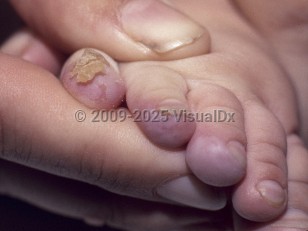Richner-Hanhart syndrome in Child
Alerts and Notices
Important News & Links
Synopsis

Richner-Hanhart, also known as tyrosinemia type 2, is an autosomal recessive disease of tyrosine metabolism. Males and females are equally affected. The first observed manifestation is often keratitis presenting in the first several years of life. This can progress to ulceration, bilateral pseudodendritic keratitis, or blindness. Classic plantar keratoderma is preceded by bullae, erosions, or erythema. Keratoderma is focal and shows a predilection to weight-bearing surfaces of the feet. Affected children can show delay or refusal to walk secondary to pain.
Intellectual disability in these patients is highly variable in severity. Many of the cutaneous manifestations can improve with dietary restrictions, and, thus, early diagnosis and intervention is paramount. Such restrictions, however, have not been shown to reverse intellectual disability. These patients have a normal lifespan.
Intellectual disability in these patients is highly variable in severity. Many of the cutaneous manifestations can improve with dietary restrictions, and, thus, early diagnosis and intervention is paramount. Such restrictions, however, have not been shown to reverse intellectual disability. These patients have a normal lifespan.
Codes
ICD10CM:
E70.29 – Other disorders of tyrosine metabolism
SNOMEDCT:
4887000 – Richner-Hanhart syndrome
E70.29 – Other disorders of tyrosine metabolism
SNOMEDCT:
4887000 – Richner-Hanhart syndrome
Look For
Subscription Required
Diagnostic Pearls
Subscription Required
Differential Diagnosis & Pitfalls

To perform a comparison, select diagnoses from the classic differential
Subscription Required
Best Tests
Subscription Required
Management Pearls
Subscription Required
Therapy
Subscription Required
References
Subscription Required
Last Updated:01/23/2022

